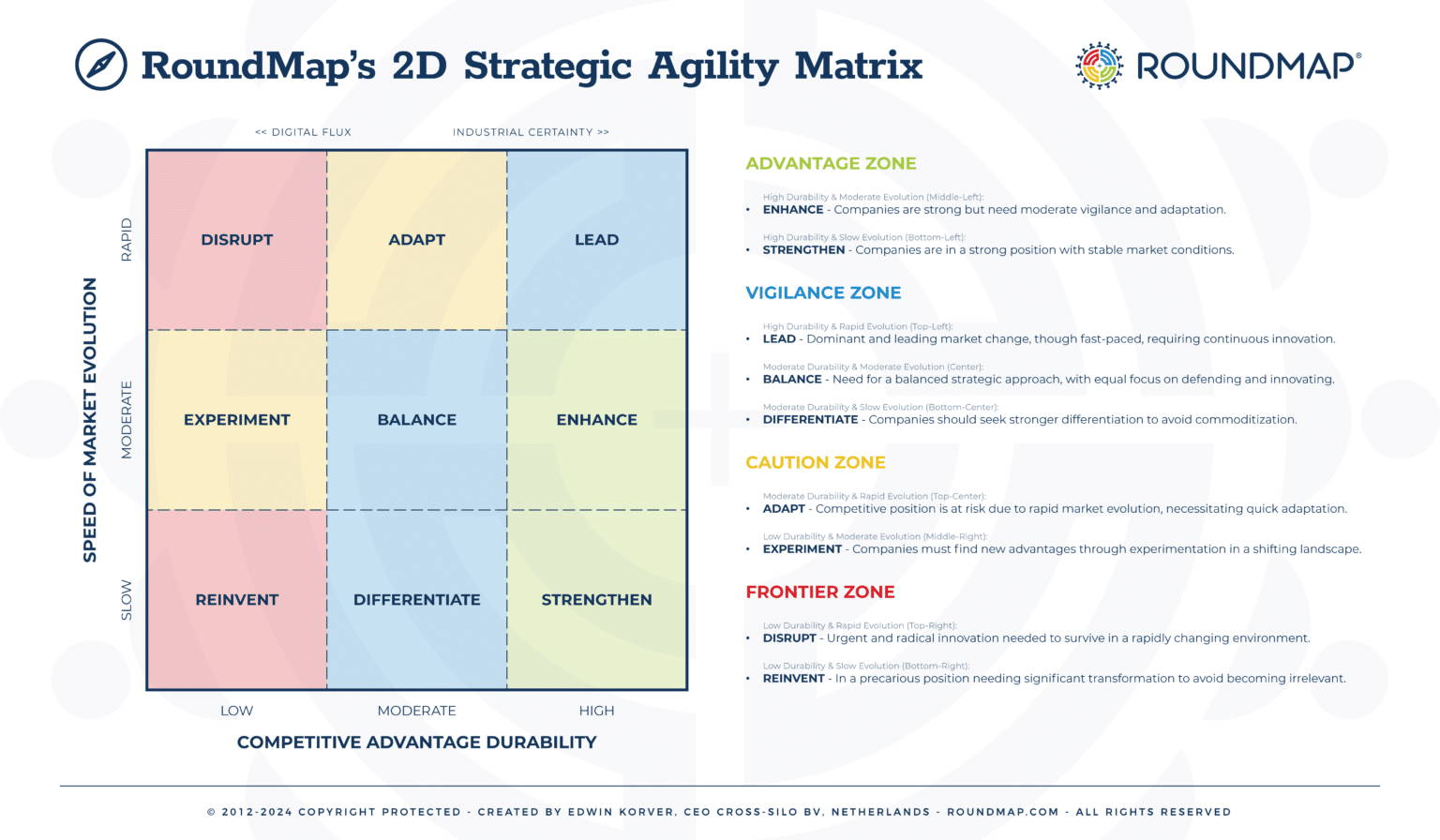In an era where the only constant is change, the ability to adapt and innovate defines the success of a business. The digital age has disrupted the conventional paradigms of competitive advantage, demanding a new strategic lens for organizations to assess and navigate the rapidly evolving business landscape.
RoundMap® presents the Strategic Agility Matrix, a cutting-edge framework that encapsulates this transformative approach to strategic planning and execution.
The Strategic Agility Matrix transcends traditional models by providing a nuanced 3×3 grid that empowers businesses to identify their strategic positions with unparalleled clarity. It delineates nine distinct quadrants, each representing a unique strategic domain within the spectrum of competitive advantage durability and market evolution speed — from the robust “Advantage Zone” to the alert “Vigilance Zone,” the preemptive “Caution Zone,” and the critical “Discontinuation Zone.”
This tool is not merely a diagnostic instrument; it’s a strategic compass for businesses aiming to thrive amidst disruption. It guides companies to leverage their strengths in stable markets, stay ahead of emerging trends, and enact transformative changes when facing potential threats. The Strategic Agility Matrix is a testament to RoundMap’s dedication to fostering resilience, continuous innovation, and sustainable growth in organizations worldwide.
Embrace the RoundMap® Strategic Agility Matrix in your strategic toolkit, and let it illuminate the path to an interconnected, adaptive, and purpose-driven business future. Now, let us reveal the very essence of this strategic guidance — the RoundMap® Strategic Agility Matrix itself.
Let’s delve into the intricacies of the Strategic Agility Matrix to uncover a strategic terrain rich with insights. Each zone and quadrant provides a typological description of the competitive scenario and prescribes the requisite strategic agility to navigate it effectively.
Advantage Zone (Green):
- Strengthen (High Durability & Slow Evolution): Organizations here are fortresses of industry, wielding significant competitive moats. The strategic focus should be leveraging and reinforcing these advantages, investing in continuous improvement, and potential market expansion.
- Enhance (High Durability & Moderate Evolution): Here lie the vigilant leaders with a firm grip on their market but must remain attuned to evolutionary shifts. Strategic agility means refining and augmenting core competencies while building responsive capabilities to emerging trends.
Vigilance Zone (Blue):
- Lead (High Durability & Rapid Evolution): These are the industry’s edge pace-setters. Sustaining a lead requires relentless innovation and a willingness to disrupt oneself. Agility here refers to continuously scanning the horizon for transformative opportunities and leading change rather than reacting to it.
- Balance (Moderate Durability & Moderate Evolution): This is the fulcrum of strategic dynamism, where organizations must strike a perfect equilibrium between leveraging existing strengths and exploring new avenues. Agility here means exploiting and exploring—fine-tuning the current model while innovating for future growth.
- Differentiate (Moderate Durability & Slow Evolution): Companies in this quadrant have a solid foothold but are at risk of becoming commoditized. Strategic agility involves identifying unique value propositions and pursuing market differentiation to strengthen brand and customer loyalty.
Caution Zone (Yellow):
- Adapt (Moderate Durability & Rapid Evolution): Organizations in this quadrant race against time and change. To maintain a competitive edge, they must demonstrate agility by swiftly adapting their strategies, embracing change, and being ready to pivot as market dynamics evolve.
- Experiment (Low Durability & Moderate Evolution): Firms here find themselves in shifting sands, where survival depends on the ability to reinvent and innovate. Agility is about experimenting with new business models, products, or services and being prepared to fail fast and learn quickly.
Discontinuation Zone (Red):
- Disrupt (Low Durability & Rapid Evolution): This quadrant is the most volatile of all terrains and calls for urgent action. Companies must be agile and audacious in their quest for relevance. It’s about being the disruptor, not the disrupted, necessitating a revolution in how the business creates and captures value.
- Reinvent (Low Durability & Slow Evolution): These organizations are on the brink, where existing strategies are failing, and the market is unyielding. Strategic agility requires bold and radical transformation—think disruptive innovation or a complete pivot in business model or market focus.
The RoundMap® Strategic Agility Matrix is a vital navigation tool, urging organizations to critically assess their competitive landscape and adapt their strategies with agility and foresight. It is a testament to the relentless pursuit of strategic mastery in an age where adaptability is synonymous with longevity.
Assessing the Position in the Strategic Agility Matrix
To determine their position within the RoundMap Strategic Agility Matrix, companies must assess two critical dimensions: Competitive Advantage Durability and the Speed of Market Evolution.
Here’s how organizations can evaluate these elements:
1. Determining Competitive Advantage Durability:
- Market Analysis: Evaluate the company’s market share, growth rate, and profitability relative to competitors. High durability often correlates with market leadership and sustained financial performance.
- Unique Value Proposition (UVP): Analyze how unique and valuable the company’s products or services are to customers. Strong UVPs that are difficult for competitors to replicate suggest high competitive advantage durability.
- Customer Loyalty and Brand Strength: Measure customer retention rates, brand recognition, and brand equity. A loyal customer base and a strong brand can indicate more durable competitive advantages.
- Barriers to Entry: Consider the barriers that protect the company from new entrants, such as patents, regulatory approvals, or high capital requirements. High barriers contribute to stronger competitive advantage durability.
- Supply Chain and Operational Efficiency: Assess the robustness of the supply chain and operational efficiencies. Superior and hard-to-replicate operational processes can enhance competitive advantage durability.
- SWOT Analysis: Conduct a SWOT analysis to understand the strengths, weaknesses, opportunities, and threats related to the business. It will highlight areas of durable competitive advantage and potential vulnerabilities.
2. Assessing the Speed of Market Evolution:
- Industry Trend Analysis: Stay abreast of industry reports, market research, and trend analyses to gauge how quickly the industry is changing. Rapid evolution is characterized by frequent technological breakthroughs, shifting consumer behaviors, and changing regulatory landscapes.
- Innovation Rate: Evaluate the rate of innovation within the company and its industry. High product development, technological adoption, and process innovation rates indicate a rapid market evolution.
- Customer Behavior Tracking: Monitor changes in customer preferences and behaviors. Markets with rapidly evolving customer needs indicate a faster evolution speed.
- Competitive Dynamics: Observe the frequency and impact of new product launches, marketing campaigns, and strategic moves by competitors. A high level of activity can signal a rapidly evolving market.
- Regulatory Changes: Keep an eye on regulatory changes that can alter market dynamics significantly. Sectors with pending or frequent regulatory shifts can face faster evolution.
- Lifecycle Stage: Determine the lifecycle stage of the industry. Emerging or growth-stage industries typically evolve more rapidly than mature or declining ones.
By following these systematic evaluations, your company can position itself within the appropriate quadrant of the Strategic Agility Matrix. This positioning is a powerful starting point for strategic planning, guiding you on the level of agility needed to either capitalize on your competitive advantages or pivot to address the challenges posed by market evolution.
Author
-
Edwin Korver is a polymath celebrated for his mastery of systems thinking and integral philosophy, particularly in intricate business transformations. His company, CROSS/SILO, embodies his unwavering belief in the interdependence of stakeholders and the pivotal role of value creation in fostering growth, complemented by the power of storytelling to convey that value. Edwin pioneered the RoundMap®, an all-encompassing business framework. He envisions a future where business harmonizes profit with compassion, common sense, and EQuitability, a vision he explores further in his forthcoming book, "Leading from the Whole."
View all posts Creator of RoundMap® | CEO, CROSS-SILO.COM






